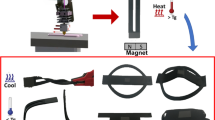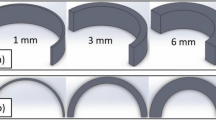Abstract
In this paper, Polyethylene Terephthalate Glycol (PETG) has been used as a novel thermoplastic thermo-responsive Shape Memory Polymer (SMP) with biocompatibility, excellent printability, cost efficiency, and transparency for the 3D/4D printing of porous structures by material extrusion. The high deformability of PETG allows for programming without an increase in temperature or the need for additional operations. This enabled the use of PETG for the Cold Programming (CP) of ordered porous shape memory structures, made possible by material extrusion printing technology. The porous samples were printed employing three patterns and two porosity percentages. The programming operation was performed at ambient temperature by applying different amounts of pre-strains under constrained and unconstrained compression modes. The constrained test was conducted using a mandrel and a matrix for exerting pure volume reduction (pure packing). The shape recovery test was accomplished above the glass transition temperature (Tg), and the fixity and recovery ratios were recorded. Employing 3D printing provided the ability to manufacture porous thermoplastic SMP structures with highly controllable pores geometry and sizes for different porosity percentages. The results showed that the combination of the uniform strain distribution in the porous structures with the help of the 3D printing process and CP on the new PETG SMP makes it possible to achieve high deformation in the glassy region, resulting in a complete shape recovery for two lozenge and vertical patterns. Among all specimens, constrained specimens by horizontal pattern had the highest fixity ratio of 90.7%. However, low fixity ratios in CP can be justified considering the existence of two stages of spring-back and structural relaxation after unloading, resulting from the elastic and viscoelastic behavior. Increasing Infill Density (ID) along with the constrained test (pure packing) improved the shape fixity. The existence of higher mechanical constraints and harsher localized deformation are speculated to be the case for this observation. Applying higher deformations (40 to 80%), for both designed tests, brought about a weakness in the shape memory performance, while it improved for 100% volume reduction.





Similar content being viewed by others
Data availability
Not Applicable.
References
Aberoumand M, Soltanmohammadi K, Rahmatabadi D, Soleyman E, Ghasemi I, Baniassadi M, Abrinia K, Bodaghi M, Baghani M. 4D printing of polyvinyl chloride (PVC): a detailed analysis of microstructure, programming, and shape memory performance. Macromol Mater Eng. 2023;308:2200677. https://doi.org/10.1002/mame.202200677.
Rahmatabadi D, Aberoumand M, Soltanmohammadi K, Soleyman E, Ghasemi I, Baniassadi M, Abrinia K, Bodaghi M, Baghani M. Toughening PVC with biocompatible PCL softeners for supreme mechanical properties, morphology, shape memory effects, and FFF printability. Macromol Mater Eng. 2023. https://doi.org/10.1002/MAME.202300114.
Zhao Q, Qi HJ, Xie T. Recent progress in shape memory polymer: New behavior, enabling materials, and mechanistic understanding. Prog Polym Sci. 2015;49–50:79–120. https://doi.org/10.1016/j.progpolymsci.2015.04.001.
Ansari M, Golzar M, Baghani M, Soleimani M. Shape memory characterization of poly(ε-caprolactone) (PCL)/polyurethane (PU) in combined torsion-tension loading with potential applications in cardiovascular stent. Polym Test. 2018;68:424–32. https://doi.org/10.1016/j.polymertesting.2018.04.032.
Li G, Xu W. Thermomechanical behavior of thermoset shape memory polymer programmed by cold-compression: Testing and constitutive modeling. J Mech Phys Solids. 2011;59:1231–50. https://doi.org/10.1016/J.JMPS.2011.03.001.
Santo L. Shape memory polymer foams. Prog Aerosp Sci. 2016;81:60–5. https://doi.org/10.1016/J.PAEROSCI.2015.12.003.
Hasan SM, Nash LD, Maitland DJ. Porous shape memory polymers: Design and applications. J Polym Sci Part B Polym Phys. 2016;54:1300–18. https://doi.org/10.1002/polb.23982.
Chevalier E, Chulia D, Pouget C, Viana M. Fabrication of porous substrates: a review of processes using pore forming agents in the biomaterial field. J Pharm Sci. 2008;97:1135–54. https://doi.org/10.1002/JPS.21059.
Chung SE, Park CH. The thermoresponsive shape memory characteristics of polyurethane foam. J Appl Polym Sci. 2010;117:2265–71. https://doi.org/10.1002/APP.32003.
Hearon K, Singhal P, Horn J, Small W, Olsovsky C, Maitland KC, Wilson TS, Maitland DJ. Porous shape-memory polymers. Polym Rev. 2013;53:41–75. https://doi.org/10.1080/15583724.2012.751399.
Kashyap D, Kishore Kumar P, Kanagaraj S. 4D printed porous radiopaque shape memory polyurethane for endovascular embolization. Addit Manuf. 2018;24:687–95. https://doi.org/10.1016/j.addma.2018.04.009.
Shirzad M, Zolfagharian A, Matbouei A, Bodaghi M. Design, evaluation, and optimization of 3D printed truss scaffolds for bone tissue engineering. J Mech Behav Biomed Mater. 2021;120:104594. https://doi.org/10.1016/j.jmbbm.2021.104594.
Xie R, Hu J, Hoffmann O, Zhang Y, Ng F, Qin T, Guo X. Self-fitting shape memory polymer foam inducing bone regeneration: a rabbit femoral defect study. Biochim Biophys Acta-Gen Subj. 1862;2018:936–45. https://doi.org/10.1016/J.BBAGEN.2018.01.013.
Small W IV, Buckley PR, Wilson TS, Benett WJ, Hartman J, Saloner D, Maitland DJ. Shape memory polymer stent with expandable foam: a new concept for endovascular embolization of fusiform aneurysms. IEEE Trans Biomed Eng. 2007;54:1157–60. https://doi.org/10.1109/TBME.2006.889771.
Sokolowski W, Metcalfe A, Hayashi S, Yahia L, Raymond J. Medical applications of shape memory polymers. Biomed Mater. 2007. https://doi.org/10.1088/1748-6041/2/1/S04. (IOP Publishing).
Huang WM, Lee CW, Teo H. Thermomechanical behavior of a polyurethane shape memory polymer foam. J Intell Mater Syst Struct 2006;17:753–60. https://doi.org/10.1177/1045389X06055768.
Tobushi H, Okumura K, Endo M, Hayashi S. Thermomechanical properties of polyurethane-shape memory polymer foam. J Intell Mater Syst Struct. 2001;12:283–7. https://doi.org/10.1106/FNSX-AP9V-QP1R-NMWV.
Tobushi H, Matsui R, Hayashi S, Shimada D. The influence of shape-holding conditions on shape recovery of polyurethane-shape memorypolymer foams. Smart Mater Struct. 2004;13:881. https://doi.org/10.1088/0964-1726/13/4/026.
Di Prima MA, Lesniewski M, Gall K, McDowell DL, Sanderson T, Campbell D. Thermo-mechanical behavior of epoxy shape memory polymer foams. Smart Mater Struct. 2007;16:2330. https://doi.org/10.1088/0964-1726/16/6/037.
Santo L, Bellisario D, Quadrini F. Shape memory behavior of PET foams. Polymers. 2018;10:115. https://doi.org/10.3390/POLYM10020115.
Song JJ, Chang HH, Naguib HE. Design and characterization of biocompatible shape memory polymer (SMP) blend foams with a dynamic porous structure. Polymer (Guildf). 2015;56:82–92. https://doi.org/10.1016/J.POLYMER.2014.09.062.
Günaydln AC, Ylldlz AR, Kaya N. Multi-objective optimization of build orientation considering support structure volume and build time in laser powder bed fusion, Mater. TEST. 2022;64:323–38. https://doi.org/10.1515/MT-2021-2075/MACHINEREADABLECITATION/RIS.
Song D, Chen X, Wang M, Wu Z, Xiao X. 3D-printed flexible sensors for food monitoring. Chem Eng J. 2023;474:146011. https://doi.org/10.1016/J.CEJ.2023.146011.
Xia BC, Huang X, Chang L, Zhang R, Liao Z, Cai Z. The arrangement patterns optimization of 3D honeycomb and 3D re-entrant honeycomb structures for energy absorption. Mater Today Commun. 2023. https://doi.org/10.1016/j.mtcomm.2023.105996.
Singh A, Wang Y, Zhou Y, Sun J, Xu X, Li Y, Liu Z, Chen J, Wang X. Utilization of antimony tailings in fiber-reinforced 3D printed concrete: A sustainable approach for construction materials. Constr Build Mater. 2023;408:133689. https://doi.org/10.1016/J.CONBUILDMAT.2023.133689.
Liu J, Zhou Y, Lu J, Cai R, Zhao T, Chen Y, Zhang M, Lu X, Chen Y. Injectable, tough and adhesive zwitterionic hydrogels for 3D-printed wearable strain sensors. Chem Eng J. 2023;475:146340. https://doi.org/10.1016/J.CEJ.2023.146340.
Aslan B, Yildiz AR. Optimum design of automobile components using lattice structures for additive manufacturing. Mater Test. 2020. https://doi.org/10.3139/120.111527.
Xu Y, Zhang F, Zhai W, Cheng S, Li J, Wang Y. Unraveling of advances in 3D-printed polymer-based bone scaffolds. Polymers. 2022;14:566. https://doi.org/10.3390/POLYM14030566.
Baptista R, Guedes M. Porosity and pore design influence on fatigue behavior of 3D printed scaffolds for trabecular bone replacement. J Mech Behav Biomed Mater. 2021;117:104378. https://doi.org/10.1016/J.JMBBM.2021.104378.
Rahmatabadi D, Ghasemi I, Baniassadi M, Abrinia K, Baghani M. 4D printing of PLA-TPU blends: effect of PLA concentration, loading mode, and programming temperature on the shape memory effect. J Mater Sci. 2023;2023:1–17. https://doi.org/10.1007/S10853-023-08460-0.
Ramezani Dana H, Barbe F, Delbreilh L, Ben Azzouna M, Guillet A, Breteau T. Polymer additive manufacturing of ABS structure: influence of printing direction on mechanical properties. J Manuf Process. 2019;44:288–98. https://doi.org/10.1016/J.JMAPRO.2019.06.015.
Cao M, Cui T, Yue Y, Li C, Guo X, Jia X, Wang B. Preparation and characterization for the thermal stability and mechanical property of PLA and PLA/CF samples built by FFF approach. Materials. 2023;16:5023. https://doi.org/10.3390/MA16145023.
Kopar M, Yildiz AR. Experimental investigation of mechanical properties of PLA, ABS, and PETG 3-d printing materials using fused deposition modeling technique. Mater Test. 2023. https://doi.org/10.1515/MT-2023-0202/MACHINEREADABLECITATION/RIS.
Barletta M, Gisario A, Mehrpouya M. 4D printing of shape memory polylactic acid (PLA) components: Investigating the role of the operational parameters in fused deposition modelling (FDM). J Manuf Process. 2021;61:473–80. https://doi.org/10.1016/J.JMAPRO.2020.11.036.
Soleyman E, Aberoumand M, Rahmatabadi D, Soltanmohammadi K, Ghasemi I, Baniassadi M, Abrinia K, Baghani M. Assessment of controllable shape transformation, potential applications, and tensile shape memory properties of 3D printed PETG. J Mater Res Technol. 2022;18:4201–15. https://doi.org/10.1016/J.JMRT.2022.04.076.
Rahmatabadi D, Soltanmohammadi K, Pahlavani M, Aberoumand M, Soleyman E, Ghasemi I, Baniassadi M, Abrinia K, Bodaghi M, Baghani M. Shape memory performance assessment of FDM 3D printed PLA-TPU composites by Box-Behnken response surface methodology. Int J Adv Manuf Technol. 2023;127:935–50. https://doi.org/10.1007/s00170-023-11571-2.
Trznadel M, Kryszewski M. Thermal shrinkage of oriented polymers. J Macromol Sci Part C. 1992;32(2006):259–300. https://doi.org/10.1080/15321799208021428.
Lim JY, Kim SY. Thermal shrinkage stress in high-speed-spun, high molecular weight poly(ethylene terephthalate) filaments. J Polym Sci Part B Polym Phys. 2001;39:964–72. https://doi.org/10.1002/POLB.1072.
Ward IM, Wilding MA, Brody H. The mechanical properties and structure of poly(m-methylene terephthalate) fibers. J Polym Sci Polym Phys Ed. 1976;14:263–74. https://doi.org/10.1002/POL.1976.180140206.
Zhang W, Chen L, Zhang Y. Thermomechanical behavior of thermoset shape memory polymer programmed by cold-compression: Testing and constitutive modeling. Polymer (Guildf). 2009;50:1311–5. https://doi.org/10.1016/j.jmps.2011.03.001.
Behl M, Lendlein A. Shape-memory polymers. In: Ishu R, editor. Kirk-Othmer encyclopedia of chemical technology. Hoboken, NJ: John Wiley & Sons, Inc.,; 2011. p. 1–16.
Acknowledgements
Not Applicable
Funding
No funding was received for conducting this study.
Author information
Authors and Affiliations
Corresponding authors
Ethics declarations
Conflict of interests
The authors declare no competing interests.
Additional information
Publisher's Note
Springer Nature remains neutral with regard to jurisdictional claims in published maps and institutional affiliations.
Rights and permissions
Springer Nature or its licensor (e.g. a society or other partner) holds exclusive rights to this article under a publishing agreement with the author(s) or other rightsholder(s); author self-archiving of the accepted manuscript version of this article is solely governed by the terms of such publishing agreement and applicable law.
About this article
Cite this article
Soleyman, E., Rahmatabadi, D., Aberoumand, M. et al. Cold programming of ordered porous PETG 4D printed by material extrusion. Archiv.Civ.Mech.Eng 24, 67 (2024). https://doi.org/10.1007/s43452-024-00879-9
Received:
Revised:
Accepted:
Published:
DOI: https://doi.org/10.1007/s43452-024-00879-9




